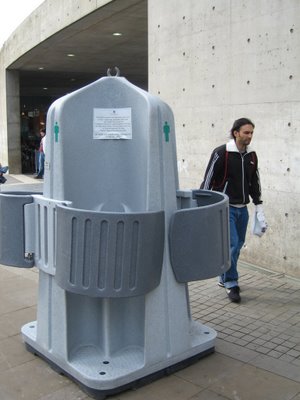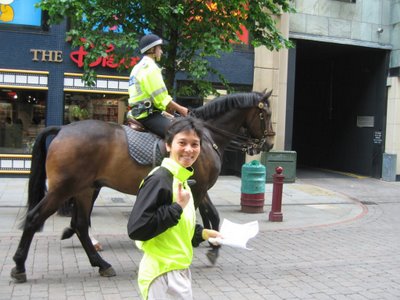The day started at 6:00am for us, packing, eating breakfast, and preparing for Lisa's longest day of the trip. Being experienced packers by now, we were on the road by 7:30am. The flat walk to Grosmont was easy and straightforward, and we arrived by 8:15, before the trains were moving, so we were denied the same spectacle we could have seen by going to the movie screens.
As the crow flies, from Grosmont to Robin Hood's Bay is only 8 miles or so. But Wainwright (who was clearly my kind of guy) was determined to put as much additional elevation gain as possible on the last day of the trip as a farewell present to those who came after him, so the route meanders South first to pick up the steep climbs and then Little Beck Woods before double-backing and heading North East. Those who are tired of all the climbing can choose to do what the Friedmans were to do today, which is to take the flat Bridleway to Whitby and then pick up the Cleveland Way down to Robin Hood's Bay.
The road past Grosmont was signed for a 33% grade, and in fact it really was steep --- for the first time on the trip, Lisa needed
both hiking sticks. Fortunately, it was foggy and cool, so we made good time, stopping only for pictures of the sign. After a good mile or so, the road flattened out near the cattle guard and we followed the sign across the parking lot onto Sleights Moor.
At the end of Sleights Moor, however, on A169, we found a bug in the Henry Stedman book: instead of turning left after crossing the road, the book indicated a right turn. After a bit of futile walking back and forth, I checked it against the Harvey Map and found the correct directions. A couple that we had met in Patterdale who were done with the trip yesterday and were driving home also stopped and confirmed my assessment of the situation.
Once we were on our way, we made reasonable time and reached
LittleBeck a little after 10:15am. We were later to find out the Peter and Margaret had left about 10 minutes before we did. LittleBeck woods is a climb, but it's gentle and beautiful, so we did not mind visiting such wonders as the
Hermitage,
Falling Foss (which was flowing quite well despite 2 weeks of dry weather!). We emerged about an hour and a half later into the car park at the top end where we had lunch and I got my last sting from the stinging nettles.
After lunch, we followed the road to the turn-off to Sneatow Low Moor, which was very dry and an easy traverse in the now sunny day. It was here that we got our first views of the North Sea in the distance, though the digital camera failed to capture the delight we felt when we saw it. Our pace quickened and soon we were over the stile and onto B1416, a tiny road which led off into the Graystone Hills.
Here the book's directions and the trails failed us, as the Moors are criss-crossed by both human and sheep trails, all of which peter'd out after the second signpost. I did my best guess with compass and map (under pressure, as we could now see Whitby on the coast), and we soon hit a fence, but it was quite obviously the wrong fence. We decided to follow the fence North and East, following more sheep trails, and after a few adventures hopping over very boggy sections that had not dried out, found the correct stile and were back onto the coast to coast trail.
The walk through Low Hawsker and High Hawsker was a long slog, and Lisa needed a break, so we stopped at the Woodland Tearoom for a cup of tea and to finish what was left of our food from the morning. Following that, a descent past the Caravans and we finally
saw the North Sea! At this point, we ran into Peter and Margaret, who were glad to take
pictures of us. The walk along the cliffs were
breath-taking and very much reminiscent of our first day of walking so long ago at St. Bees. We took it easy to savor every moment, but even so, arrived quickly at
Robin Hood's Bay at 4:00pm.
Robin Hood's Bay is exactly the kind of village that inspired Miyazaki's view of Europe in
Kiki's Delivery Service or
Howl's Moving Castle. The houses are stacked and jumbled up all the way down the cliffs, and afar all you see is a chain of chimneys down to the Bay. It was a picture perfect ending to the walk.
There, we checked into our Bed and Breakfast, walked down to the
Bay Hotel, and had our picture taken at the end. We were not alone, however, as we soon found
our compatriots and had a great drink, signing the guest book at Wainwright's Bar, and then a filling dinner.
 This got rolled out in front of our eyes as we were headed to the shopping area. Would you use this? What would the equivalent version for women look like?
This got rolled out in front of our eyes as we were headed to the shopping area. Would you use this? What would the equivalent version for women look like? 
 This got rolled out in front of our eyes as we were headed to the shopping area. Would you use this? What would the equivalent version for women look like?
This got rolled out in front of our eyes as we were headed to the shopping area. Would you use this? What would the equivalent version for women look like? 
 It's so unfair. Not just a bike response unit, but real mounted police too! And he wasn't a loner for tourists (Manchester not being really much of a tourist town), but had 2 or 3 compatriots!
It's so unfair. Not just a bike response unit, but real mounted police too! And he wasn't a loner for tourists (Manchester not being really much of a tourist town), but had 2 or 3 compatriots! 
 Perhaps it should not be surprising that a country where 30% of trips are done by bicycle (this was in Manchester, England) would have a cycle response unit for emergency response in the pedestrain only part of town. She was wearing an NHS logo, so this was the official government unit. Her panniers has room for most first aid gear, as well as an AEB.
Perhaps it should not be surprising that a country where 30% of trips are done by bicycle (this was in Manchester, England) would have a cycle response unit for emergency response in the pedestrain only part of town. She was wearing an NHS logo, so this was the official government unit. Her panniers has room for most first aid gear, as well as an AEB.